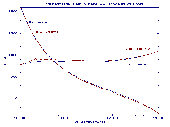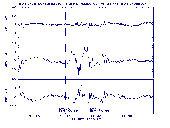- structure of the inner magnetosphere magnetic field;
- structure of the small scale field-aligned currents;
- dynamics of the field-aligned currents during substorms;
- relation of the processes in the auroral zone and in the tail.
PI: V.A.Styazhkin, styazkin@izmiran.rssi.ru
Co-i: V.G.Petrov (data processing and archiving, vpetrov@izmiran.rssi.ru),
A.Bochev.
The IMAP-3 instrument is designed to measure three components of the DC magnetic field in two ranges: +/- 6800 nT with resolution 1 nT and +/- 68000 nT with resolution 10 nT. Usually magnetometer data are transmitted to the scientific SSNI telemetry system with rate of one vector per 3 seconds, during special intervals data are transmitted to telemetry with rates 2 or 8 vectors/s depending on the instrumentís operating mode.
The INTERBALL-2 spacecraft has been successfully launched on 29 August 1996. The IMAP-3 was initially tested on the 9th of Sept and started to work regularly on the 14th of Sept.
 Fig. 1 shows measured Bx (directed to the Sun) and Byz (perpendicular
to the direction to the Sun) components of the magnetic field and Tsyganenko
model magnetic field components. There are good agreement in Bx component
and reasonable agreement in Byz. We cannot calculate now By and Bz components
separately due to absence of the spacecraft attitude data.
Fig. 1 shows measured Bx (directed to the Sun) and Byz (perpendicular
to the direction to the Sun) components of the magnetic field and Tsyganenko
model magnetic field components. There are good agreement in Bx component
and reasonable agreement in Byz. We cannot calculate now By and Bz components
separately due to absence of the spacecraft attitude data.
 Fig. 2 shows magnetic field perturbation (deviation from undisturbed
main field). At 21:30-21:40 variations up to +/- 30 nT mainly in By component
are seen. Spacecraft at that moment was near midnight, so By component
was directed along L-shell and it is reasonably to consider this variation
as produced by field-align currents.
Fig. 2 shows magnetic field perturbation (deviation from undisturbed
main field). At 21:30-21:40 variations up to +/- 30 nT mainly in By component
are seen. Spacecraft at that moment was near midnight, so By component
was directed along L-shell and it is reasonably to consider this variation
as produced by field-align currents.